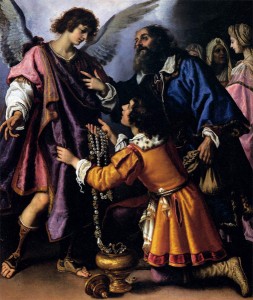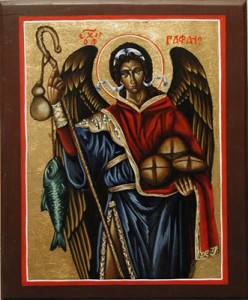For I am the angel Raphael, one of the seven, who stand before the Lord.
Of the three Angels named in the Bible, St. Raphael gets, perhaps, the least attention today. This is a real pity, because, in a society that needs healing as never before in our time, and which is made up of so many strangers and migrants, the work of St. Raphael in the lives of the Church and her children is really essential.

BILIVERT, Giovanni, The Archangel Raphael Refusing Tobias's Gift. 1612, Oil on canvas, 175 x 146 cm, Galleria Palatina (Palazzo Pitti), Florence
Much of what the Church knows of St. Raphael comes from the book of Tobit, wherein the heavenly spirit disguises himself as a man and acts as both the companion and guide of Tobias. He prays for him, prescribes a cure for his father’s blindness, and saves his wife from the devil. The Angel then reveals himself to be, as the opening quote tell us, one of the seven archangels who stand ever before the face of God; the other two named in the Bible are of course Ss. Gabriel and Michael.
But the Old Testament is not necessarily the only place that St. Raphael makes his appearance in the Bible. Many of the Church Fathers had speculated on whether or not he was the angel mentioned in John 5:1-4, which speaks of the pool called Probatica, where the ill were brought for healing: “an angel of the Lord descended at certain times into the pond; and the water was moved. And he that went down first into the pond after the motion of the water was made whole of whatsoever infirmity he lay under.” This account was made the Gospel reading for the Mass of the feast of St. Raphael in the traditional calendar (October 24) — which continues to be observed not only in communities which follow the Extraordinary Form of the Roman Rite, but also in those locales where St. Raphael is a patron. In the Ordinary Form, of course, he is grouped with St. Michael and the other angels on Spetember 29.
 Due to his actions in the Book of Tobit and the Gospel of John, St. Raphael is accounted patron of travelers, the blind, happy meetings, nurses, physicians, Christian marriage, and Catholic studies. As a particular enemy of the devil, he was revered in Catholic Europe as a special protector of Catholic sailors: on a corner of Venice’s famous Doge’s Palace, there is a relief depicting Raphael with Tobias on his knees holding a scroll on which is written: Efficia fretum quietum (“Keep the Gulf quiet”). On July 8, 1497, when Vasco Da Gama set forth from Lisbon with his four ship fleet to sail to India, the flagship was named — at the King of Portugal’s insistence — the St. Raphael. When the flotilla reached the Cape of Good Hope on October 22, the sailors disembarked and erected a column in the archangel’s honor. The little statue of St. Raphael that accompanied Da Gama on the voyage is now in the Naval Museum in Lisbon.
Due to his actions in the Book of Tobit and the Gospel of John, St. Raphael is accounted patron of travelers, the blind, happy meetings, nurses, physicians, Christian marriage, and Catholic studies. As a particular enemy of the devil, he was revered in Catholic Europe as a special protector of Catholic sailors: on a corner of Venice’s famous Doge’s Palace, there is a relief depicting Raphael with Tobias on his knees holding a scroll on which is written: Efficia fretum quietum (“Keep the Gulf quiet”). On July 8, 1497, when Vasco Da Gama set forth from Lisbon with his four ship fleet to sail to India, the flagship was named — at the King of Portugal’s insistence — the St. Raphael. When the flotilla reached the Cape of Good Hope on October 22, the sailors disembarked and erected a column in the archangel’s honor. The little statue of St. Raphael that accompanied Da Gama on the voyage is now in the Naval Museum in Lisbon.
In Tuscany, and many other places, every teenager who left home for the first time was placed under the Archangel’s care. St. Raphael was called there Adolescentium pudicitiae defensor — “defender of adolescent chastity.” In token of his defense of travelers, one of the largest Catholic Emigrants’ Aid groups, the St. Raphael’s Society, was founded in Hamburg in 1871 to help Catholics of all nationalities arriving in America. Various offshoots of the original group in a number of different countries continue the work today.
St Raphael is presented to us, above all in the Book of Tobit, as the Angel to whom is entrusted the task of healing. When Jesus sends his disciples out on a mission, the task of proclaiming the Gospel is always linked with that of healing. The Good Samaritan, in accepting and healing the injured person lying by the wayside, becomes without words a witness of God’s love. We are all this injured man, in need of being healed. Proclaiming the Gospel itself already means healing in itself, because man is in need of truth and love above all things. The Book of Tobit refers to two of the Archangel Raphael’s emblematic tasks of healing. He heals the disturbed communion between a man and a woman. He heals their love. He drives out the demons who over and over again exhaust and destroy their love. He purifies the atmosphere between the two and gives them the ability to accept each other for ever. In Tobit’s account, this healing is recounted with legendary images. In the New Testament, the order of marriage established in creation and threatened in many ways by sin, is healed through Christ’s acceptance of it in his redeeming love. He makes marriage a sacrament: his love, put on a cross for us, is the healing power which in all forms of chaos offers the capacity for reconciliation, purifies the atmosphere and mends the wounds. The priest is entrusted with the task of leading men and women ever anew to the reconciling power of Christ’s love. He must be the healing “angel” who helps them to anchor their love to the sacrament and to live it with an ever renewed commitment based upon it. Secondly, the Book of Tobit speaks of the healing of sightless eyes. We all know how threatened we are today by blindness to God. How great is the danger that with all we know of material things and can do with them, we become blind to God’s light. Healing this blindness through the message of faith and the witness of love is Raphael’s service, entrusted day after day to the priest and in a special way to the Bishop.
There are very many cities dedicated to the healing Archangel; but perhaps none is so fervent as Cordova, Spain, due to a series of apparitions of the Archangel there during the 16th century; in response to the City’s appeal, Pope Innocent X allowed the local celebration of a feast in the Archangel’s honor on May 7, the date of the principal apparition. St. John of God, founder of the Hospital order that bears his name, also received visitations from St. Raphael, who, as with Tobias, encouraged and instructed him. In tribute to this, many of the Brothers Hospitallers of St. John of God’s facilities are called “Raphael Centers” to this day. The 18th century Neapolitan nun, St. Maria Fracesca of the Five Wounds similarly had visions of St. Raphael, who healed her of several maladies. Here in California, our own Mission San Rafael (center of the later town of that name in Marin County) began as a hospital and recovery center for the Indians from fog-bound Mission San Francisco de Asis; so successful was it that it became an independent mission on its own.
Even as the Pontiff observes, we have great need of St. Raphael’s powers of healing and clarity. Bolstered by the knowledge that he inevitably comes to the aid of those who pray for his guidance, we in Los Angeles should look to St. Raphael for help in:
- Healing the divisions in Church and State
- Aiding the ill and the homeless
- Assisting the traveler and the migrant — be their journeys physical or spiritual
- Seeing things as they are: from God’s perspective, rather than our own
Given his record, the bright archangel will surely come to our aid if we ask him.
Links
- The Archangel Raphael and Cordoba
http://wikanda.cordobapedia.es/wiki/Arc%C3%A1ngel_San_Rafael - St. John of God and the Angels
http://www.pontifex.roma.it/index.php/opinioni/consacrati/1553-san-giovanni-di-dio-e-gli-angeli - Feast and Shrine of St. Raphael, Ollur, India
http://en.wikipedia.org/wiki/Feast_of_Saint_Raphael,_Ollur - Prayers to St. Raphael
http://www.2heartsnetwork.org/Raphael.htm